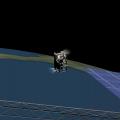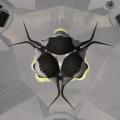About This File
Space Odyssey 2040
Space Odyssey demo movie
Installation
Liftoff Tutorial
Rendezvous Tutorial
MMU EVA Tutorial
Power Sat Module EVA Tutorial
Starlifter SPS Departure Tutorial
Starlifter Atmospheric Re-Entry Tutorial
Starlifter Crew Emergency Escape System demo (mission provided – use JATO button)
REQUIRED ADDONS:
Florida KTTS Shuttle Facility
http://forums.x-plane.org/index.php?app=downloads&showfile=20590
HIGHLY RECOMMENDED ADDONS:
International Space Station (ISS) – required for ISS EVA bonus mission
http://forums.x-plane.org/index.php?app=downloads&showfile=14361
INSTALLATION INSTRUCTIONS:
1). Unzip “Space-Odyssey-2040.zip”
2). Place the folder titled “SPACE-ODYSSEY-2040” into your “C:/….X-Plane/Aircraft/space craft/” directory. This folder must be in the directory in order for the situations to load properly.
3). Place the folder titled “SpaceOdyssey2040Missions” into your “C:/….X-Plane/Output/Situations/” directory.
This addon makes extensive use of X-Plane “situations”. Situations are finicky, but I’ve found a way to make them work…
HOW TO OPEN SITUATIONS CORRECTLY – IMPORTANT PLEASE READ!! –
1). Pause the simulator.
2). Open the desired situation from the X-Plane drop down menu.
3). Make sure the simulator is still paused. If not, then re-pause the simulator.
4). Open the exact same situation TWO MORE TIMES.
5). After the third situation load you may un-pause the simulator. Make sure your throttle is at 100% for liftoff and reentry situations. All other situations the throttle should be set at 0% upon loading the situation.
This project was conceived as a tour de force of hypothetical near-future mega-engineering. It centers around the “Solar Power Satellite” (SPS) concept that was first proposed in the 1970’s. In this scenario, large photovoltaic arrays are constructed in orbit to supplement earth based alternative energy. These “photon farms” then convert this energy into Infrared beams that illuminate strategically located heat sinks as the need for power in that region arises. The earth based heat sinks contain heat exchangers that boil water into steam for electrical power generation.
More than a year of research, planning, calculating, modeling and experimentation resulted in the development of the Starlifter “Triamese” HLLV – (Heavy Lift Launch Vehicle). This system is designed to be an efficient and cost effective vehicle for the delivery of SPS components into low-earth-orbit (LEO). Secondary missions include space mining operations, delivery of large space station modules, and delivery of large off-planet habitat modules to LEO. Payload capacity is about 100 to 180 metric tons depending on mission parameters.
At liftoff, the boosters act as auxiliary fuel tanks for the orbiter through a fuel exchange process known as “cross-flow”. After pushing it to a height of 300,000 feet, and a speed of Mach 6+, the boosters then detach, and return to the launch site with a “boost-back” burn of their remaining fuel. Meanwhile, the orbiter after separation (staging), begins drawing fuel from its own onboard tank, and continues to orbit. All stack components are fully reused.
Flight characteristics:
*Re-entry AOA should be held constant at as close to 22 degrees as possible. AOA past 30 degrees, or excessive roll past 45 degrees, or yaw past 3 – 4 degrees will result in departure from controlled flight.
*Main wings should only be extended below Mach 0.95
*AOA past 30 – 40 degrees with airspeed below 200 knots may result from an unrecoverable deep-stall. Ignore the stall warning during liftoff and re-entry, but pay close attention to it as speed drops below supersonic.
*Flaps are available, but unnecessary and create excessive drag.
*FLARE EARLY!!! The Starlifter’s flight deck sits about 50’ above the ground. Contact with the runway will be a surprise.
*I highly suggest that you familiarize yourself with Starlifter’s HUD, and instrument displays before liftoff.
*The square red JATO button turns on the boosters at liftoff, but also activates the emergency escape module when you are performing the emergency escape mission.
The “Space Turd” asteroid is made from a 3d scan that was completed by the Japanese space agency in 2005 of the asteroid “Itokawa”. For that mission you will be able to explore a real life asteroid. The mission scenario is that in the near future, Itokawa has been captured and carefully steered into orbit by unmanned probes for the purpose of space mining.
Special thanks to:
Steve Wilson for scripting and flight testing.
AI for his water tower models which were used in the launch facility.
Lance Lobo for his sky diver, which I transformed into the MMU, Russian SPK, and Zero-G-Forklift
Johnny Forehead for his high-resolution parachutes.
Mr. Scott for his superb liftoff sounds.
Kovarik from turbosquid.com for his Caterpillar 797F heavy tow-truck
Michael Carbagal and NASA for the space shuttle launch gantry which was downloaded and modified from nasa.gov
Robert Gaskell, “The Planetary Institute”, and the Japanese Space Agency JAXA for the 3D model of Itokawa Asteroid
Austin Meyer and Laminar Research for providing us all with such a well stocked sand-box.
Possible future addon situations:
*Delivery and assembly of mars bound habitat modules.
*Assembly of habitat modules, and refueling depot modules onto the surface of Itokawa.
*Assembly of deep space telescopes and sensors in the shadow of one of the SPS platforms





















